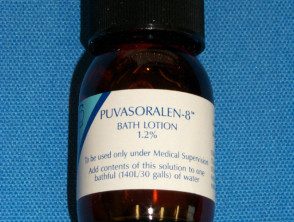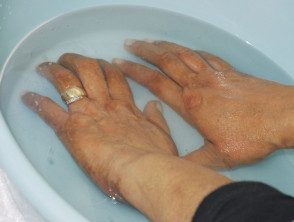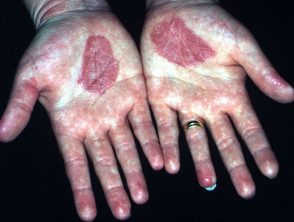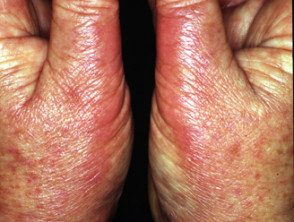What is PUVA bath water?
PUVA bath water, also called bath water or balneo-photochemotherapy, is a treatment for skin diseases. It is a type of phototherapy.
PUVA is an acronym: "P" is for psoralen, a drug. It is used in combination with "UVA" or the Ultraviolet radiation wavelength 320–360 nm.
The most commonly prescribed psoralen is methoxsalen (8-methoxypsoralen), but 5-methoxypsoralen and trisoralen are sometimes used. Psoralen can be taken orally (by mouth).
PUVA bath water refers to the prescribed psoralen in a dilute solution of water, generally 3 mg / L. The part to be treated is soaked in this solution before exposure to the UVA rays emitted by special fluorescent lamps.
What skin disorders are treated with PUVA bath water?
PUVA bath water is used to treat inflammatory skin disorders, mainly:
- Psoriasis
- Eczema/ /dermatitis
- Vitiligo
- Cutaneous T cell lymphoma
PUVA whole body bath water is prescribed to treat extensive skin conditions, but it is not widely available due to its expense, inconvenience, and risk.
Located PUVA bath water is more common. It is most often prescribed for psoriasis or eczema affecting the hands and feet.
How is PUVA bath water made?
- The affected areas are covered with a psoralen solution mixed with warm water and soaked for 15 to 30 minutes.
- The skin dries gently. Some centers recommend a waiting period of 15-30 minutes while the solution penetrates the skin, while others treat immediately.
- The affected skin is exposed to UVA rays emitted by special fluorescent lamps.
- Treated skin should be covered for the next 2 to 3 days, especially outdoors, to protect it from accidental UVA exposure.
Whole body soaks
The patient is immersed in a bathtub with psoralen solution and then stands in a full-body cabinet containing 6-foot fluorescent tubes that emit UVA.
Hand and foot soak
The hands or feet are soaked in a container or bucket with psoralen solution and then exposed to UVA rays from the 2-foot bulbs in a hand-foot box.
The actual duration of treatment will depend on the wattage of the lamps, the number of lamps, the patient's skin type, and previous exposure. It can vary from less than a minute to half an hour or more.
The phototherapy staff will measure the output of the lamp and calculate the required UVA dose. The dose can be increased at each visit according to a protocol. The dose will stay the same or be reduced if the condition clears, the maximum dose is reached, or side effects such as burns occur.
Hand and foot soak

Hands and feet soak up PUVA

Hands and feet soak up PUVA

Hands and feet soak up PUVA
How many treatments are needed?
PUVA bath water is most often done two or three times a week. The number of treatments varies depending on the severity of the skin condition and the response to PUVA. It can range from 10 to 60 treatments in total.
Treatment usually stops when the skin condition has disappeared, but in some cases maintenance treatments are used, for example, once a week.
PUVA in bath water can also be stopped if it is ineffective or if there are significant adverse effects.
What are the results of the treatment?
Between 60 and 80% of psoriasis patients have good results with PUVA in bath water in 20 to 40 treatments. Success rates for eczema are somewhat lower.
What precautions are necessary?
Follow the instructions of the phototherapy staff.
- Keep all scheduled appointments.
- Tell the staff about your health problems and the medications you take.
- Do not apply any cream to the area to be treated until later.
- Avoid sun exposure on treatment days and without treatment.
- PUVA bath water is not made during pregnancy or lactation.
What are the side effects?
The treated areas are expected to be slightly pink after each treatment. The pink color can last for several days and may be accompanied by temporary itching or itching. The skin is usually dry; apply moisturizers frequently. Tanning generally occurs and is more prominent on darker skin types.
Burning
Burns can occur if exposure to UVA rays has been prolonged. The peak time for burning is 48 to 72 hours after exposure to UVA rays. Slightly burned areas may itch and appear red. In severe cases, pain and blisters can occur.
An increased risk of burns occurs in the following circumstances:
- Light skin: Fitzpatrick skin phototype 1 or 2
- If a higher concentration of psoralen solution is used
- If the treated areas are exposed to the sun or another source of UVA after the treatment
- If a phototoxic medication is taken before treatment
- If the course of treatment is interrupted; the dose should be reduced when recommending.
In case of burn, apply cooling emollients frequently. Anti-inflammatory Medications such as aspirin or ibuprofen can reduce discomfort. It may take several days or more to recover from PUVA burns, as they are longer than normal sunburns.
Burning hands after PUVA gets soaked

Burning hands after PUVA gets soaked

Burning hands after PUVA gets soaked
Skin Cancer
Long-term, 200 or more oral whole-body PUVA treatments have been associated with skin cancer, waterfalls and skin aging, such as freckles, wrinkles, and increased dryness. The hazards of PUVA bath water are unknown.
Combined treatments
PUVA bath water can be done at the same time as other treatments for the skin condition. These include current creams (eg, corticosteroids for eczema) and oral medications such as prednisone, acitretin, and methotrexate.
PUVA bath water is best avoided by those taking azathioprine and cyclosporine because these drugs are immunosuppressive and can increase the risk of skin cancer.
Certain topical preparations such as sunscreens and calcipotriol should not be applied to the skin to be treated, as they can reduce their effect. Cosmetics and perfumes should also be avoided, as they are phototoxic and can cause severe burns.
What if the skin condition does not go away?
There may be other options available to treat your skin condition. Consult your dermatologist as advice.

